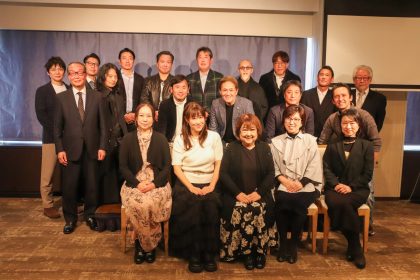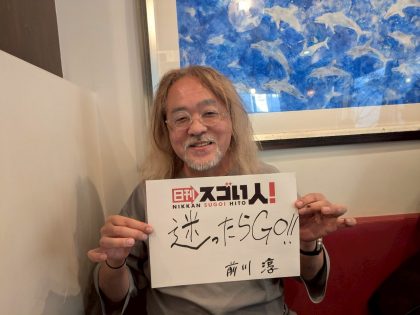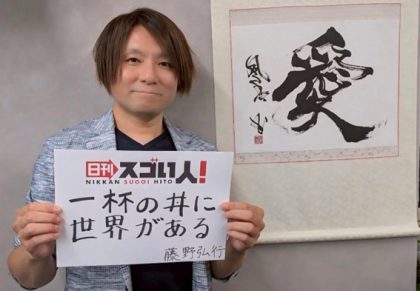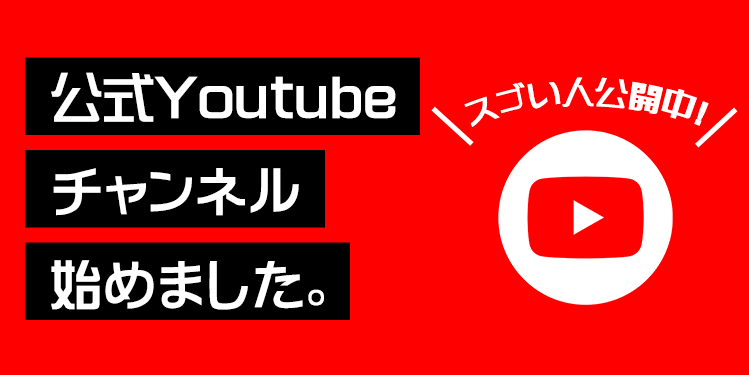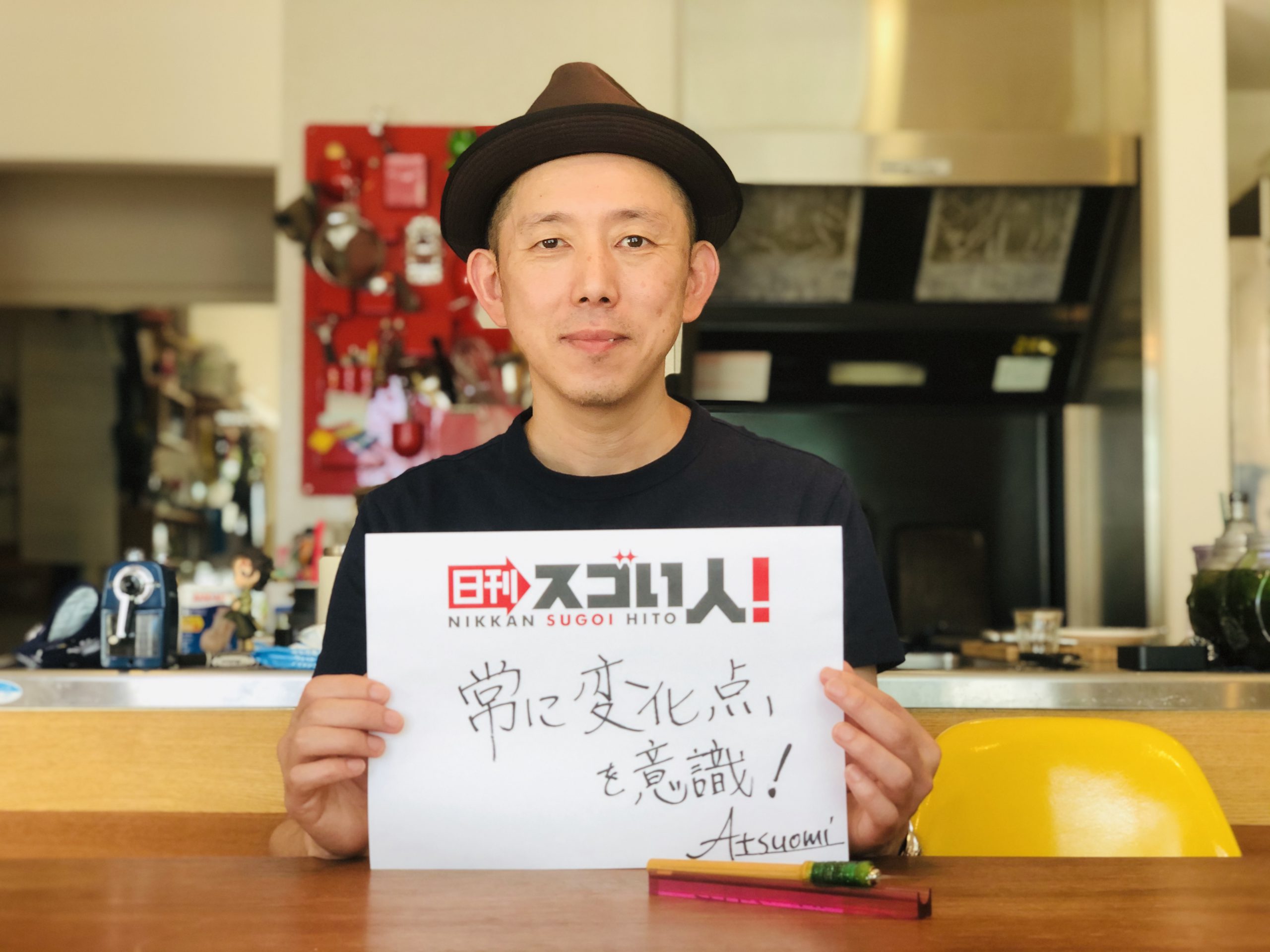
The paper cutting artist Nakamura Atsuomi <YouTube> Becoming Aware of the Meaning Behind Art From OverseasWhen talking about foreign countries, I've so far put on exhibitions in France and New York.Overseas, people think my art is very different to their image of Japan, and so the reaction has been positive with many people showing interest.In Japan people say “Sugoi”, and overseas I've heard people often call my work “amazing”. However, there are different meanings to amazing.At exhibitions in Japan people often ask, “what have you drawn?”, “what were you trying to communicate through this work?”When asked these questions I explain my thoughts, and what I was was trying to express about myself. However, abroad, conversely, people often say, “perhaps the artist was trying to express this?”, or “when I look at this art, I feel this, but is it right?”. There's a trend that everyone comes with their own ideas and then verifies whether they are right or wrong.Fundamentally, it's best to give each person their own answer, and from there view the art. 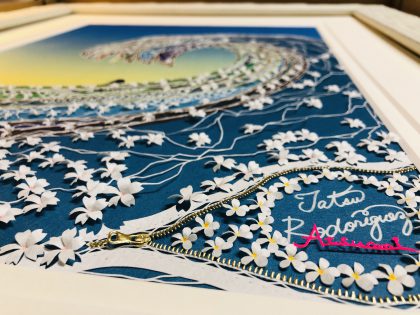 I think that's interesting.For example, I have a piece of work which is a dragon split into 4 pieces. Japanese people are the dragon's head,They say they want the face part.It seems that perhaps 4 was too many pieces.However, foreigners conversely say they don't need the head.They just want the body and the legs. When I ask the reason why, they say that they want to use them to decorate the living room where their family gather. If they get the head, even though it looks cool, people will just say, “it's a dragon right”, and no more conversation will be born from it.However, if they put up the legs, then conversations can spring from it, for example “is that a dragon?”.It makes sense, this is the other side of amazing, the different roles of art.Art can play the role of interior decorations, and also the role of a tool for facilitating human communication.Whichever role you place the higher importance on determines which part you will buy.Neither reason is wrong. I think this difference is interesting. The Depth of Possibilities that Cutting Art HoldsRecently I've been trying out a new experiment; with the help of the industrial goods manufacturer, Mikasa Sangyo from my native Yamaguchi prefecture, we've developed a new illuminated paper cutting technique. We developed a technique for making fluorescent paint using pulverised ink or toner.So by combining this with cutting art, I made a multi-sensory room as a piece of art.By multi-sensory I am referring to a way of thinking where the goal is creating a society where able and disabled people are able to live together effectively. This way of thinking is based on creating a space where people can relax effectively.In this space, people with mental disabilities or cognitive impairments are able to achieve a high level of relaxation due to the stimulation of their senses.We have the visitors of the exhibition wear 3-d glasses so that they may experience the world created through the combination of 3 dimensional cutting art and fluorescent paint.The visitors spend a long time in this exhibition.I don't think that this is unrelated to the relaxing effect created by the sensory art environment.When you think about a piece of art, there is also the possibility of a commercially produced item could be art.This is because there will be a part of it which is not commercial, but it's purpose, and art can be included in this.The multi-sensory room is an instance imaging art and society co-existing.From here, many different variations, can be created, influenced by either commercial or social factors, which have here to for not been seen before. Resolving upon using paper cutting as artThe culture of Paper cutting in Japan existed for more than 1000 years.Using washi Japanese paper and similar products s a material, it was employed for Shinto rites and festivals.
I think that's interesting.For example, I have a piece of work which is a dragon split into 4 pieces. Japanese people are the dragon's head,They say they want the face part.It seems that perhaps 4 was too many pieces.However, foreigners conversely say they don't need the head.They just want the body and the legs. When I ask the reason why, they say that they want to use them to decorate the living room where their family gather. If they get the head, even though it looks cool, people will just say, “it's a dragon right”, and no more conversation will be born from it.However, if they put up the legs, then conversations can spring from it, for example “is that a dragon?”.It makes sense, this is the other side of amazing, the different roles of art.Art can play the role of interior decorations, and also the role of a tool for facilitating human communication.Whichever role you place the higher importance on determines which part you will buy.Neither reason is wrong. I think this difference is interesting. The Depth of Possibilities that Cutting Art HoldsRecently I've been trying out a new experiment; with the help of the industrial goods manufacturer, Mikasa Sangyo from my native Yamaguchi prefecture, we've developed a new illuminated paper cutting technique. We developed a technique for making fluorescent paint using pulverised ink or toner.So by combining this with cutting art, I made a multi-sensory room as a piece of art.By multi-sensory I am referring to a way of thinking where the goal is creating a society where able and disabled people are able to live together effectively. This way of thinking is based on creating a space where people can relax effectively.In this space, people with mental disabilities or cognitive impairments are able to achieve a high level of relaxation due to the stimulation of their senses.We have the visitors of the exhibition wear 3-d glasses so that they may experience the world created through the combination of 3 dimensional cutting art and fluorescent paint.The visitors spend a long time in this exhibition.I don't think that this is unrelated to the relaxing effect created by the sensory art environment.When you think about a piece of art, there is also the possibility of a commercially produced item could be art.This is because there will be a part of it which is not commercial, but it's purpose, and art can be included in this.The multi-sensory room is an instance imaging art and society co-existing.From here, many different variations, can be created, influenced by either commercial or social factors, which have here to for not been seen before. Resolving upon using paper cutting as artThe culture of Paper cutting in Japan existed for more than 1000 years.Using washi Japanese paper and similar products s a material, it was employed for Shinto rites and festivals. 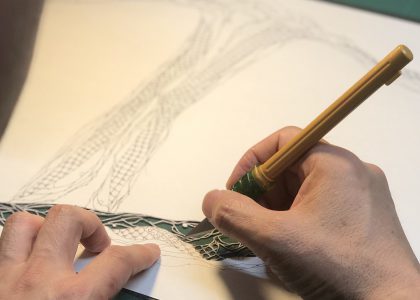 Whichever it is used for, it is a traditional hand craft.Therefore I am challenging myself to use modern materials when creating my art.So when you use Paper cutting as a technique, you are not just limited to paper.If you think about what is necessary in the modern age, instead of paper, we can use acrylic or construction materials. Over the last 20 years I have had many opportunities to experiment with various materials from the construction industry.Trying out their hardness, flexibility, warmth or coldness.Because I understand the way of using the traditional materials, bringing them into a new world is fresh and exciting.Mixing Washi paper with an acrylic board for the background.It's something that hasn't existed until now, it will be a completely new world. I plan on creating space.We are also producing the new luminescent paper cutting materials.I've been thinking that it would be great if children could also become familiar with paper cutting.Paper cutting as an art form has no exit, so to speak, it is unlimited.It is uncommonly fragile and easily broken, but it is this reason that it's existence transmits power around it.Therefore if anyone is careful as long as they use enough time they can produce it. With a machine even more amazing things can be made. I think that the era where paper cutting means just cutting paper is already over.Similar to when the digital camera was released, and taking pictures and videos stopped being hard work, in the current age 3D printers can easily produce objects that surpass high level hand techniques. In such an age, we artists must, “through the production of art, ask some question”. As far as innovation goes, the delicacy and preciseness of the pieces should be increased to a satisfactory level.It is not something that the analogue work of a human can cross sword's with.However, when it comes to things that machines can't do, such as living and breathing, only humans can make works dealing with these topics.As an artist, what do you want to show with paper cutting? what message do you want to transmit to society?Just answering these questions is a large part of what it means to be an artist.Many cultural arts change over time, and grow with the changes.If you take Heart Sutra for example, when mixed with Hatsune Miku it can become pop or rock.I too, when I have need, borrow power from machines.With this, from those intricate pieces of work something special is unleashed, and the passion and zeal of the artist are concentrated into the expression we mentioned before, so that they may communicate what they wish.Which means, that my works are for this reason, rather than a large collection of paper cuttings, art which uses the idea of paper cutting.
Whichever it is used for, it is a traditional hand craft.Therefore I am challenging myself to use modern materials when creating my art.So when you use Paper cutting as a technique, you are not just limited to paper.If you think about what is necessary in the modern age, instead of paper, we can use acrylic or construction materials. Over the last 20 years I have had many opportunities to experiment with various materials from the construction industry.Trying out their hardness, flexibility, warmth or coldness.Because I understand the way of using the traditional materials, bringing them into a new world is fresh and exciting.Mixing Washi paper with an acrylic board for the background.It's something that hasn't existed until now, it will be a completely new world. I plan on creating space.We are also producing the new luminescent paper cutting materials.I've been thinking that it would be great if children could also become familiar with paper cutting.Paper cutting as an art form has no exit, so to speak, it is unlimited.It is uncommonly fragile and easily broken, but it is this reason that it's existence transmits power around it.Therefore if anyone is careful as long as they use enough time they can produce it. With a machine even more amazing things can be made. I think that the era where paper cutting means just cutting paper is already over.Similar to when the digital camera was released, and taking pictures and videos stopped being hard work, in the current age 3D printers can easily produce objects that surpass high level hand techniques. In such an age, we artists must, “through the production of art, ask some question”. As far as innovation goes, the delicacy and preciseness of the pieces should be increased to a satisfactory level.It is not something that the analogue work of a human can cross sword's with.However, when it comes to things that machines can't do, such as living and breathing, only humans can make works dealing with these topics.As an artist, what do you want to show with paper cutting? what message do you want to transmit to society?Just answering these questions is a large part of what it means to be an artist.Many cultural arts change over time, and grow with the changes.If you take Heart Sutra for example, when mixed with Hatsune Miku it can become pop or rock.I too, when I have need, borrow power from machines.With this, from those intricate pieces of work something special is unleashed, and the passion and zeal of the artist are concentrated into the expression we mentioned before, so that they may communicate what they wish.Which means, that my works are for this reason, rather than a large collection of paper cuttings, art which uses the idea of paper cutting.
中村敦臣 切り絵アーティスト
公式サイト:https://www.atsuomi.jp/
Facebook: https://www.facebook.com/atsuomikirie
Instagram: https://www.instagram.com/atsuomi._paper_cut_artist/
光る折り紙販売店:浜松町 宇宙の店 https://spacegoods.net/
◆プロフィール
1974年山口県生まれ。 切絵アートクリエーター
2011年 国際グループ展(ニューヨーク・セーラムギャラリー)
2012年 国際グループ展(ニューヨーク・セーラムギャラリー
2014年 第15回ジャパンエキスポ招待作家(フランス パリ)
2015年 マイフェアドラゴン展(東京 南麻布 シャラ・パール)
2016年 もしもしにっぽんFESTIVAL 2016(東京 渋谷)
2017年 ONISHI PROJECT/Winter Group Show(アメリカ ニューヨーク)

